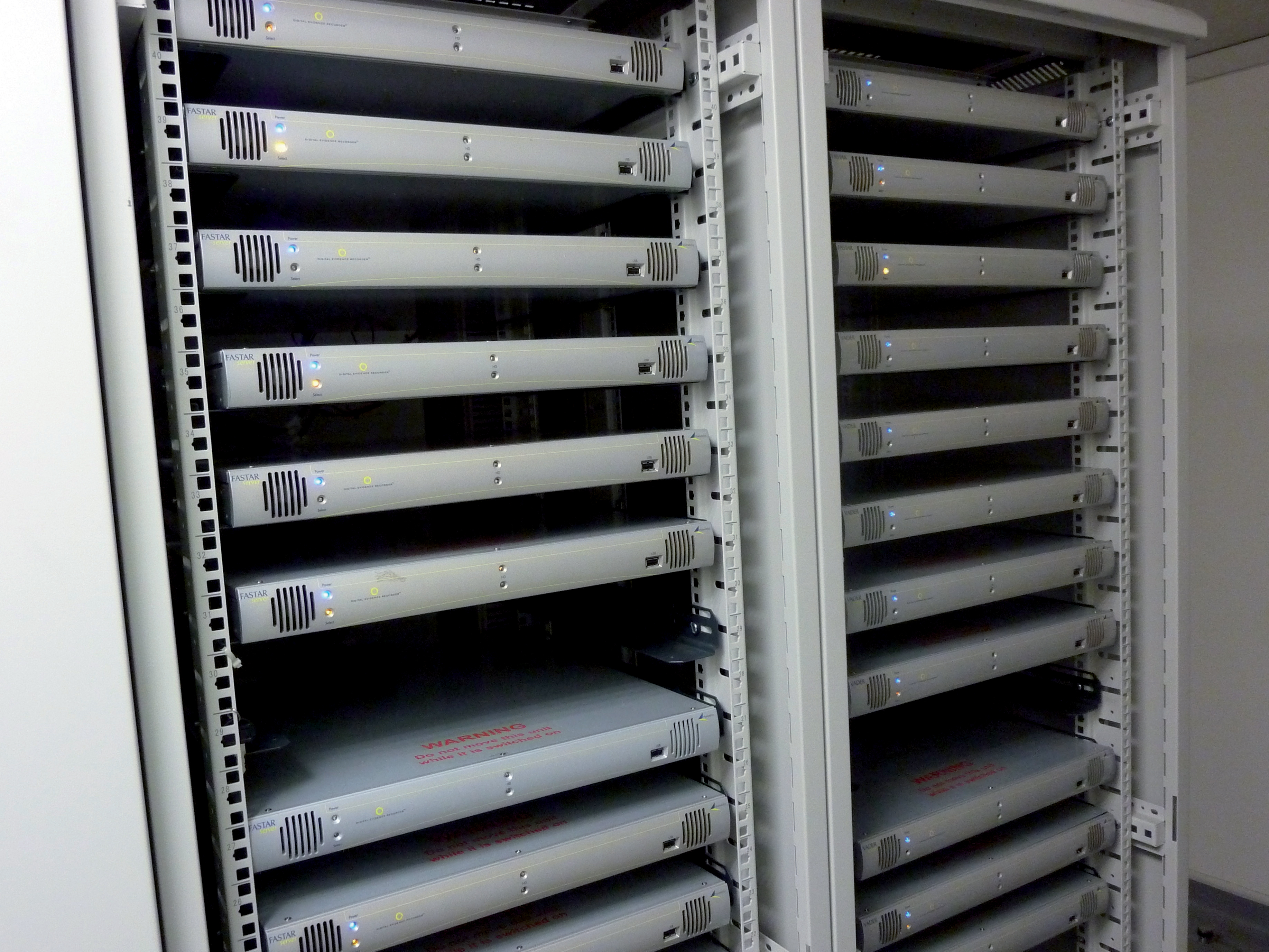
The need for more detail within stored images means that maintaining adequate storage capacity will continue to be an issue for video network operators
The IP Revolution for CCTV systems which has been predicted for some years now has failed to happen, says Craig Howie, commercial director of
Storing large amounts of CCTV recordings increases the risks associated with maintaining and accessing the information as time progresses. Redundancy and robustness are already more frequent requirements. Hence, it's now timely to look at how we build systems which are able to cope.
Traditionally CCTV system design has been focused on the parameters of resolution, frame rate and storage period. It is very rare that the extent or results of digital compression are even considered. It is clear that the amount of compression you apply significantly affects the detail available within an image, as well as the amount of network bandwidth and disk storage used. Apply a lot of compression and you suffer from loss of the detail within the image but gain in terms of reduced bandwidth and storage requirements. Moving forward it will become increasingly important to understand the effects of this trade-off between image detail and bandwidth/storage usage in practice. Image detail is essential especially when used for identification and/or evidence... a core reason for investing in a CCTV system in the first place.
With the introduction of megapixel cameras into CCTV systems, there are practical considerations. For a start, not every camera in every system need be megapixel. Many are under the impression that by moving all your camera technology straight to megapixel you can, in effect, replace four or five standard definition (SD) cameras with a single megapixel camera. I'd argue that that's a theoretical view that won't hold up in practice. Using a single megapixel camera provides a superb overview with the ability to accurately identify detail retrospectively. But many CCTV systems, particularly observation-critical applications, are used for real-time monitoring. Megapixel cameras can provide higher-resolution images covering large fields of view which are ideal for post-event investigation over a large area. However, you can't have a camera (even a megapixel camera) covering a very large field of view while at the same time being trained on specific areas for real-time monitoring requiring shorter, narrower fields of view.
Megapixel cameras can aid and improve the results of CCTV systems but for the foreseeable future they are more likely to co-exist with existing analogue cameras within hybrid systems. In effect you have an overview camera with excellent post-event detail but need alternative sources to provide live video for more immediate surveillance activities.
Consider the limitations
Unfortunately the focus of new or emerging technologies within the CCTV industry centres on product features in isolation. For example, consider a megapixel camera capable of streaming out video at 6Mb/s. The initial discussions on the camera's capabilities are focused on the image quality, detail and data rate. You see the quality of output from a demonstration using one or maybe two cameras. So far, so good. Now consider adding megapixel cameras to your network, say 16 of them. Like most organisations, you operate a typical 100Mb network. Adding 16 megapixel cameras to your 100Mb network will simply saturate it. In practice the throughput of an IP network is only 70-80 per cent of the total available bandwidth. (There are ways around this but these involve more detailed network design and segmentation - a whole subject in its own right!) Taking a product in isolation and focusing on individual features or capabilities is fraught with risk in this new landscape of network video. Many manufacturers are pushing technology for technology's sake and I caution end users to demand more focus on the practicalities and limitations as well as the benefits of the complete system, rather than individual products operating in isolation.Unless there is a massive investment in the infrastructure bandwidth - and I can't see that taking place any time soon - then, logically, distributed video recording is the most practical way to design a CCTV system that uses networks. This is valid both for traditional analogue systems recording to DVRs and IP-based systems recording to NVRs. Bear in mind that when you're using an end-to-end IP system the bottleneck within the overall system is the network connection between the cameras and the NVR. Once you go beyond that, you're streaming video for the purpose of viewing or displaying, and that takes up much less bandwidth. Having a large number of cameras focused towards a single NVR increases the risk of network saturation and then you have a serious problem. If you spread the recording points out in the network this will alleviate the bandwidth need across the organisation and keep the points of concentration towards the edge of the network.
Competing standards
The traditional analogue CCTV system has worked very well on the basis of standardisation. All equipment meeting the PAL standard was instantly compatible with any other PAL-standard equipment including DVRs, matrices, displays and so on. Moving to an entirely IP-based CCTV system is a whole shift away from standardisation. In terms of end-to-end network video you need to appreciate that any solution, so far, has in fact been a bespoke system. Manufacturers are all deciding on their own form of communication between each piece of equipment. The IP network is really only the 'conduit' for moving data across the wires. To date the format of information between products is a bespoke implementation used by each individual manufacturer. Because of that, users risk getting seriously hijacked by or at the very least tied to a single manufacturer.There is some light on the standards horizon with two loosely competing initiatives: ONVIF and PSIA. Both have their own merits but ONVIF is by far the most advanced with the largest community of manufacturers signed up. But we're in an unsettled state and it doesn't make sense to have two different organisations driving the process. There will only be one winner and there is no guarantee the outcome will be the best technological solution. Unsurprisingly ONVIF seems to have taken the lead but PSIA's brief actually offers a wider conceptual proposal. Everyone agrees that we need to move to a point where we can make future product development compliant to a common standard and theoretically it's a good idea. How far it will go in practice is another matter and we'll have to wait and see.
I call on manufacturers to become much better at disclosing their standards and to offer software development kits that are not only readily available but also updated on a regular basis. At least until we have a universal standard - and that still seems to be some way off. Unfortunately too many users have lost out because of the commercial conflict of manufacturers not wanting to make available the means to control, access or view video from within their equipment.
Battling 'entrenched attitudes'
So, how do we ensure that specifiers, systems integrators and ultimately users have a progressive path to follow? The only guarantee we have is that things will continue to become even more sophisticated with multiple and overpowering capabilities. Which route should you take to protect your existing investment, and more to the point, who should you trust in terms of where to get the best advice with so much conflicting information available? Common standards will be the great stepping-stone but meanwhile we have to make do without. It is the understanding of the system capabilities that is key, not so much of the individual product, although that will obviously become important as you start choosing products under your buying cycle. Even more important is the role of the consultants. I am unfortunately apprehensive of whether the consultants fully understand how to build resilient networks from the ground up. The really big question is: should security consultants, who typically originate from careers in the military or the police, really be specifying the complexities of network infrastructure products. There is reason to split the process into risk assessment and risk management on the one hand and the technological complexities required of the network on the other.It boils down to an educational process. There are two key concepts to understand: how networks integrate and operate; and how digital compression affects the final output of the system. Once you master these you are well on the way to understanding how networked video products can and will work together.
For high-value systems it's not a question of ripping out an entire system and replacing it. You have to evolve your existing system through hybrid integration. We are now firmly within the realms of networked video technology. You need to consider the process on migration and which path to choose. Due caution must be taken to the progress and the understanding. Take a look at how products function together in practice. If you feel an aspect of the technology will compromise your system then it's probably not worth using.












